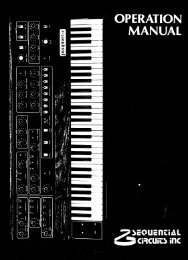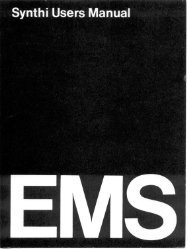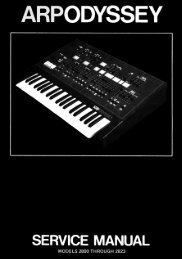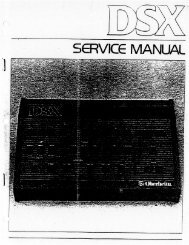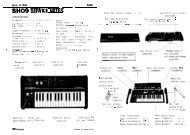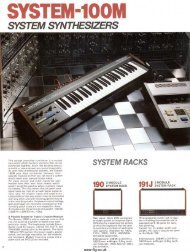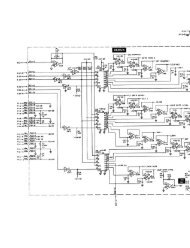ARP2600 - Fundamentals of Music Technology - Cyborgstudio.com
ARP2600 - Fundamentals of Music Technology - Cyborgstudio.com
ARP2600 - Fundamentals of Music Technology - Cyborgstudio.com
Create successful ePaper yourself
Turn your PDF publications into a flip-book with our unique Google optimized e-Paper software.
SECTION2 VCO-1ALL ABOUT OSCILLATORSOscillators are the fundamental part <strong>of</strong> any synthesizer. They are the module that creates the raw soundthat will be shaped and molded by all the other parts <strong>of</strong> the synthesizer. Oscillators function by puttingout voltage in a pattern. The faster they put out the pattern, the higher the frequency they produce.When this output voltage is amplified and connected to a speaker, a sound can sometimes be heard.Some people think that oscillators only put out voltage when a key is being played on the keyboard.This really isn’t true, though. Oscillators constantly oscillate at a specified rate, even if a key isn’t beingplayed. Another word for rate is frequency and it is measured in Hertz (Hz).+10Volts0timeFigure 2-1: A square waveVCO stands for voltage controlled oscillator. This means thatthis module is an oscillator and can produce audio signals andcontrol signals. It also means that at least one <strong>of</strong> its parameterscan be controlled via voltage control. This is another perfectexample <strong>of</strong> the term ‘voltage controlled’ being used as an adjectiveas mentioned in Section 1.Most oscillators are capable <strong>of</strong> producing different tone colors. This is ac<strong>com</strong>plished by putting outvoltage in a pattern called a waveform. For instance, to create a square wave (see Figure 2-1), theoscillator will put out no voltage for a moment, then put out ten volts for a moment. To produce a sawwave (see Figure 2-2), the oscillator must increase its voltage gradually to ten volts, then drop sharplyback to zero volts.Repeating a waveform very quickly (<strong>of</strong>ten thousands <strong>of</strong> timesper second) produces an electronic signal which human earswill perceive as a tone after it is amplified and is connected toa speaker. Notice when the raw output <strong>of</strong> an oscillator is connectedto a speaker that the sound is not particularly interestingto listen to. Because the sound is static and unchanging, it israther monotonous or boring.10volts0timeFigure 2-2: A saw waveTHE OSCILLATOR’S TIMBREOscillators have two different parameters, the first <strong>of</strong> which is timbre. Timbre <strong>com</strong>es from French, andis pronounced tam-ber. Timbre means tone color or raw sound. When timbre changes, the shape <strong>of</strong> thewaveform changes. One can easily see by <strong>com</strong>paring Figures 2-1 and 2-2 above that a square wavedoes not look anything like a saw wave. The two will sound different as well, just the way a pianosounds different from a trumpet, even if each sounds the same note.One selects a timbre by connecting a patch cord to one <strong>of</strong> the oscillator’s two outputs. In Figure 2-3,VCO-1’s two outputs jacks can be seen. The top jack constantly puts out a saw wave and the bottomjack puts out a square wave. It is very important to note that connecting a patch cord to one <strong>of</strong> the two011




